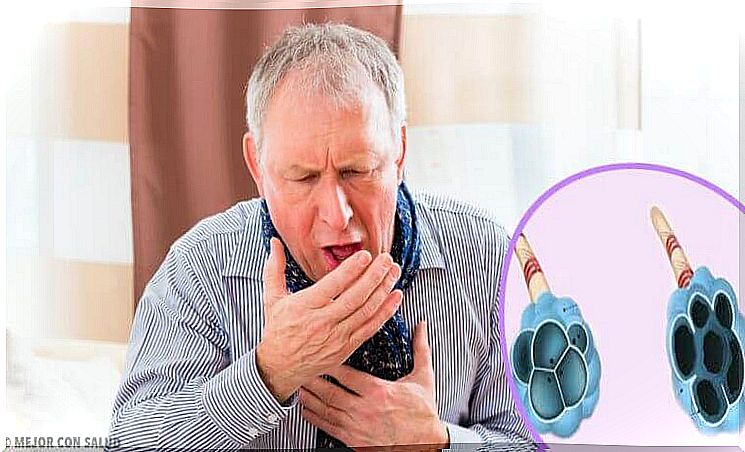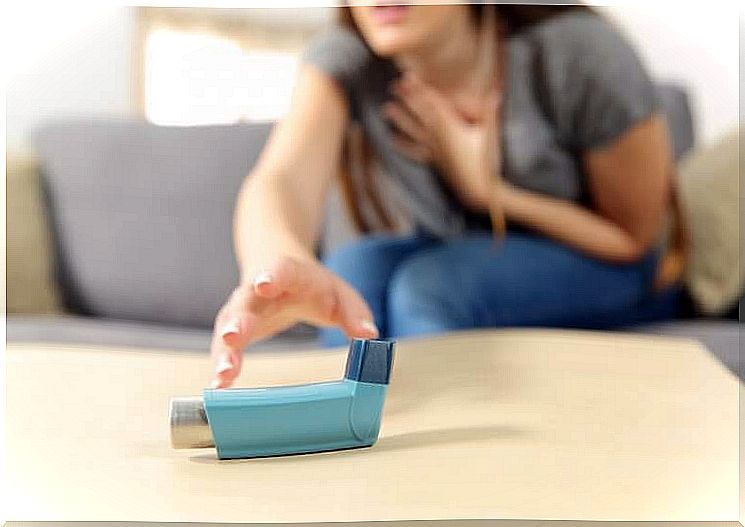The Causes And Symptoms Of COPD

Chronic obstructive pulmonary disease, more commonly known as COPD, is a condition that slowly worsens over a long period of time. It affects your lungs and makes it difficult to breathe. This creates difficulties in performing our daily tasks. The symptoms of COPD thus threaten our quality of life.
Often the term COPD is used to describe chronic bronchitis and emphysema. These are two progressive lung diseases that can occur separately or together. The most common form of COPD is a combination of these 2 conditions.
Chronical bronchitis
As the name implies, it is a chronic inflammation (constant) of the airways (bronchi) in the lungs. Chronic bronchitis is defined as a cough that produces phlegm. This cough is daily and lasts for at least 3 months. In addition, this complaint occurs for two or more consecutive years.
Bronchitis causes the lungs to produce excess mucus to keep the bronchial tubes moist. This causes coughing and narrowing of the airways, making it difficult for the oxygen to flow freely. As a result, the patient feels that he is short of air.
emphysema

Emphysema occurs when the alveoli in the lungs lose their elasticity and enlarge and begin to hurt. This makes the transfer of oxygen from the lungs to the bloodstream less efficient. The alveoli collapse, meaning they can’t support the microscopic airways called the small bronchi. This produces breathing problems that make it extremely difficult to inhale and exhale.
What are the symptoms of COPD?
The symptoms of COPD usually develop slowly over many years. Most days, the main symptoms of COPD are:
- labored breathing
- wheezing
- tightness in the chest
- productive cough (coughing up phlegm).
A doctor will determine whether the COPD is mild, moderate, or severe, depending on several factors. First, he will see if the patient has symptoms of COPD. How much effort it takes for the person to exhale. It also looks at how much the daily life of this person is limited.
Then he will check whether the patient has frequent infections in the respiratory tract (cold or flu). Whether he has a chronically productive cough (persistent). It is also checked how often there is an exacerbation. It should be noted that people with COPD generally experience exacerbations. These are deteriorations, so-called outbreaks of the situation. This is often caused by a respiratory infection, such as a cold.
Severe COPD

In the severe stage of COPD, there may also be other symptoms and signs of severe lung disease, such as:
- A blue tint to the skin (cyanosis).
- Fluid retention, which can lead to swelling in the feet, ankles, and legs.
- extreme fatigue
- Unwanted Weight Loss
What Causes COPD?
The vast majority of COPD cases are caused by smoking. Exposure to secondary tobacco smoke, especially during childhood, can increase your risk of developing COPD. In some cases, however, COPD can result from prolonged exposure to dust or chemical smoke at work. Air pollution also contributes to the development and worsening of symptoms.
Risk Factors

In addition to smoking and exposure to dust and smoke, which puts you at risk, there are several other factors that can increase your chances of developing COPD. These factors are:
- Family history of COPD (especially if they were a smoker).
- Family history of asthma (and if they have suffered from it for a long time).
- Problems with airways and lungs during childhood.
Tests and Diagnosis
To get a diagnosis for COPD, a doctor will evaluate the patient. Through certain tests, he will learn more about the person’s state of health. Even more than the clear picture of the symptoms and the information obtained by interviewing the patient.
Of course, the doctor should check whether the patient is a smoker or has ever smoked and whether he works in a place where there is exposure to dust, gases or smoke.
The tests that allow them to explore the background of the patient’s health status are:
- Lung function examination. Spirometry is a lung function test that has the patient breathe into a machine called a spirometer. The most important values for diagnosing COPD are the total amount of air exhaled and the amount exhaled in one second.
- A chest X-ray or a CT scan. These studies may show features that suggest that someone may have COPD. These images can help reveal other conditions that could be causing the symptoms.
- Measuring the gas in the arterial blood. These tests measure the amount of oxygen and carbon dioxide in the bloodstream. This helps to evaluate how well the lungs are functioning.
Complications
- Anxiety and Depression
- heart failure
- Type 2 diabetes
- Pulmonary hypertension (high arterial pressure and the blood vessels of the lungs)
- Polycythemia (increase in red blood cells)
- Osteoporosis (a condition in which the bones become less dense and strong, increasing the risk of fractures)
When should you consult a doctor?

When someone has been a smoker, is over the age of 35 and shows the following symptoms:
- Difficulty breathing and also a wheezing sound while breathing. Initially, this is usually only noticed during physical activity.
- Productive cough (coughing with phlegm) that affects the person a few times a day, most days.
- Frequently suffers from respiratory infections (such as the common cold causing a cough).
What can be done about it?
The most important thing you can do if you have COPD is to stop smoking immediately. It will improve your cough, reduce your difficulty breathing and also reduce lung damage.
COPD is a progressive disease and unfortunately there is no cure for it. It is also not possible to reverse the lung damage that has already occurred. However, there are treatments available that help improve lung function. They can also relieve symptoms and slow the progression of the disease.









